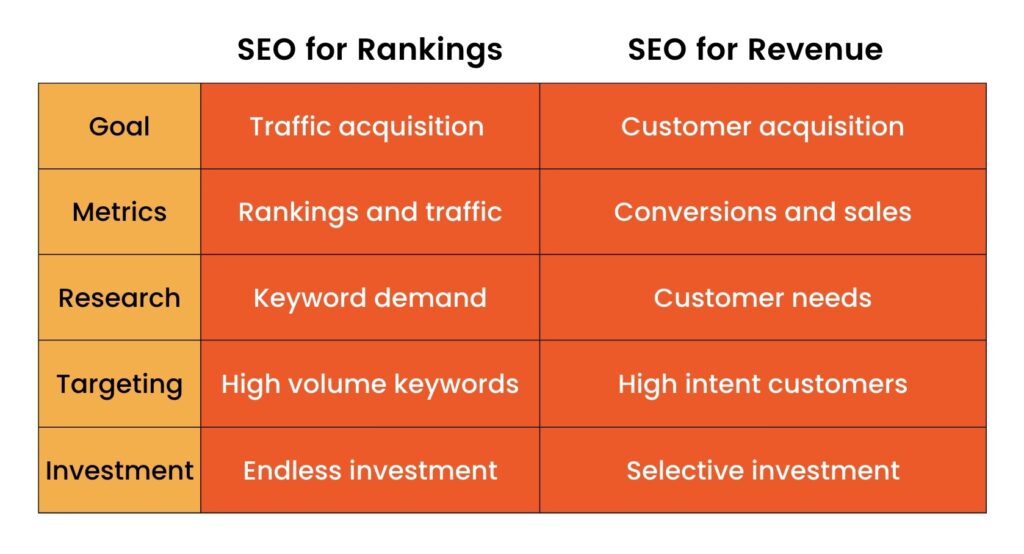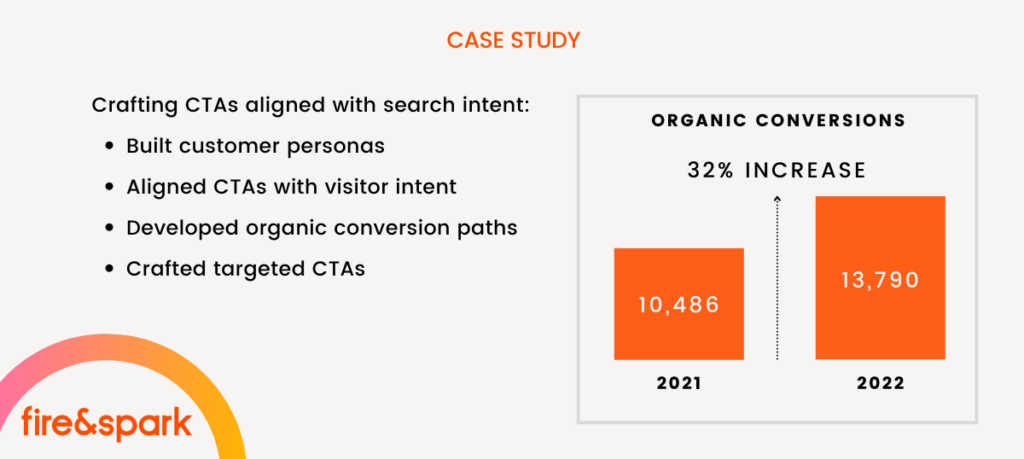Since 2008, our clients and partners have known Fire&Spark as an SEO agency.
However, the digital marketing landscape is constantly changing.
Fire&Spark is evolving to stay ahead of this change. Our work still involves generating organic traffic, but growing our clients’ organic revenue is our primary concern.
SEO has always aimed to increase organic search visibility, primarily by improving search engine rankings. But, we can no longer take for granted that search rankings will lead to revenue growth.
Open secret: SEO campaigns often improve rankings and traffic without delivering real business impact.
How did we get here?
Recent trends, like Google’s shift to generative AI, changes in consumer search behavior and increasing competition, are forcing SEO specialists to modernize their strategies.
Organic search will remain a valuable source of high-intent, cost effective traffic for years, but many SEO “best practices” are obsolete. They must be replaced with strategies purpose-built for AI search engines.
To make matters worse, SEO is still synonymous with rankings in the minds of most marketers. Optimising for rankings alone is a recipe for disappointing results. Better rankings often fail to deliver tangible business impact, like conversions, revenue or SQLs.
Our industry’s focus on rankings prevents us from replacing outdated SEO best practices with modern strategies designed to help businesses grow, not just outrank their competitors.
Today, SEO strategy must be coordinated with conversion strategy. Otherwise, SEO campaigns may generate organic traffic that fails to produce meaningful revenue. This involves a deep understanding of the target customer and crafting messaging aligned with search intent that your customer feels speaks to their unique needs.
Marketers have long known the effort required to properly profile their customers. At Fire&Spark, we have spent hundreds of hours with our clients’ customers to better understand their needs, problems and preferences. But, SEO specialists still hide behind keyword databases and analytics tools. It’s time to stop hiding behind keyword tools and talk directly to customers or frontline salespeople.
The “SEO agency” label links us to an industry that is falling behind, reluctant to let go of obsolete best practices and ill-equipped to navigate the impending wave of change.
The SEO industry needs to change.
It’s time to shift our focus from rankings and traffic to sales and revenue.
By focusing on customer needs, not the search engine, with revenue as our goal instead of rankings, SEO will deliver consistent growth well into the future.
With this shift in thinking an entirely new SEO strategy emerges. An approach to SEO that helps businesses grow. We call this approach SEO for revenue. It replaces the ineffective SEO for rankings paradigm.
At Fire&Spark, we set out to build an entirely new SEO methodology and reshape our industry. We designed our SEO framework for business impact measured by conversions, revenue and SQLs.
To build our new SEO methodology, we started with the desired outcome and worked our way backwards.

Fire&Spark is leading this change. This year we will invest our time into educating our clients, training marketing agencies, presenting at 30+ industry conferences in 2023 and coaching in-house marketing teams.
Revenue Optimization, Not Search Optimization
What’s wrong with rankings and traffic as an SEO campaign goal?
Rankings and traffic don’t guarantee conversions.
In our work, we’ve seen the same pattern over and over: Marketing teams traumatized by disappointing SEO campaign results.
Typically, they start with strategies to improve their keyword rankings. Then, they invest months in content creation and authority building before seeing significant organic traffic growth. Finally, they turn their attention to conversion optimization to generate sales.
But, it’s too late.
When organic visitors fail to convert into buyers, frustrated marketers shift their resources to other channels – if leadership doesn’t pull the plug first.
Different Goal, Different Strategy
It turns out that SEO for rankings requires a fundamentally different approach than SEO for revenue.
When you craft an SEO strategy with conversion as the primary goal, an entirely different approach to SEO strategy emerges.
Specifically, rankings and traffic are just intermediate steps to your ultimate goal.
SEO for rankings aims to acquire traffic, while SEO for revenue aims to acquire customers.

Expertise in conversion strategy is critical and traditional SEO blog articles are mostly replaced by alternative content formats that have been proven to convert better. Understanding customer needs is more important than in depth keyword research. Strategic investment in SEO, rather than limitless spending, becomes a viable option.
SEO Rooted in Revenue Optimization.
Every dollar spent on marketing must deliver a tangible return. SEO efforts that only result in rankings and traffic have minimal business impact.
SEO “best practices” are usually implemented without conversion optimization in mind. This leads many SEO agencies and in-house teams to persist with losing strategies like pouring resources into blog articles that produce inconsistent results, low conversion rates, high bounce rates and miserable scaling challenges.
The traditional approach to SEO demands that marketers deploy resources in ways that are often counterproductive.
Examples of counterproductive tactics:
- Starting with keyword research, not customer research
- Developing content to generate traffic, rather than revenue
- Optimizing for high volume keywords, not high intent keywords
- Addressing customers’ frequently asked questions, rather than purchase intent questions
- Publishing blog articles, not alternative content formats proven to convert
- Sending spam emails for backlinks, not building relationships with organizations that Google trusts
By shifting the focus to sales and revenue, SEO campaigns make better use of resources and achieve impactful business results that will delight your leadership.
Here’s an example… We recently worked on an SEO project for an online electronics retailer. By reviewing the paths visitors took through their website, analyzing conversion data and interviewing members of their sales team we were able to identify customer pain points with high purchase intent—before we did any keyword research.
Conversion Maximizing SEO
The contrast between traditional SEO strategy and conversion focused SEO strategy is striking.
Traditional SEO campaigns start with questions about keywords:
What are the relevant keywords?
Which keywords have the most search volume?
How competitive are these keywords?
But, rankings and traffic are only important if you target the right customers.
Conversion focused SEO campaigns start with questions about customers:
What are the customers’ pains?
What information does the customer need to purchase?
What questions do customers ask when making a purchase?
Conversion maximizing SEO strategy, unlike traditional SEO strategy, emphasizes revenue generation over traffic generation. This means that conversion optimization is a top priority from the beginning, rather than an afterthought.
Traffic Quality Matters, A Lot
Traditional SEO treats conversion as an afterthought—neglecting the first rule of conversion strategy:
Rule #1 – Start with high quality, relevant traffic.
To maximize conversions from organic traffic, you must target searchers who have demonstrated a clear intent to explore or purchase your offerings.
For example, visitors who arrive at a craft brewery’s website may have searched for “craft beer” or “craft beer recipe”. But these queries have vastly different intent.
The “craft beer” search is much more likely to convert into a sale because the searcher has purchase intent. In contrast, the “craft beer recipe” search is unlikely to generate a sale because the searcher is looking for a home brew recipe.
This makes perfect sense. Right?
Apparently not.
Many SEO agencies and consultants take credit for organic traffic growth, whether it converts into sales or not.
Even when SEO campaigns attempt to target high value keywords, a quick examination of analytics data would confirm much wasted time and effort.
Typically, the majority of organic traffic generated from SEO campaigns (especially when the content strategy is centered on blogging) comes from low intent searches, depressing conversion rates.
Offers Matter Too
Then, there’s the second rule of conversion strategy:
Rule #2 – Provide a clear, compelling offer.
Offer messaging plays a pivotal role in conversion.
When you understand the preferences, attitudes, and worldviews of your target audience, it’s easier to craft irresistible offers. Offers aligned with the search intent that brought the visitors to your website in the first place.
To maximize conversion, you need calls-to-action (CTAs) tailored for each stage of the buyer journey.
By ensuring that CTA offers are tailored to each stage of the buyer journey, you can efficiently guide organic visitors through the sales funnel, ultimately converting more of them into buyers.
Example: Unique CTAs for a Craft Brewery Website

The diagram above shows the buyer journey for the customers of a craft brewery. The offers are specific to each stage of the journey.
The beer tasting checklist offer is most effective as a lead generation strategy for craft beer enthusiasts who are discovering the brand for the first time.
The virtual happy hour offer is best suited for customers who have already enjoyed the product and are open to deeper engagement with the brewery’s products.
Each of these offers is designed to appeal to the target customer at a specific stage of the buyer journey and guide them to the next stage, ultimately resulting in a purchase or repurchase.
Here are the results of a project we undertook to improve the CTAs on a B2B service website.

We achieved 32% lift in conversions. But, we could have done much better if we had run their SEO campaign from the start. We would have started with conversion in mind.
Evidence-based SEO
We have a client that we’ve worked with for 4 years. When we started out working with them, we were able to achieve a 40% increase in organic revenue via metadata optimizations and hyper-targeted ecommerce collection pages. As we reached diminishing returns on these tactics, we turned our attention to what would come next.
Through our twice-yearly assessment of client results, we identified the new most effective tactics and chose accordingly. Rather than driving the collection page creation strategy into the ground while ROI evaporated, we were able to use our evidence-based approach to continue the growth.
We identified an opportunity to transform their standard collections into comprehensive buying guides. The effectiveness of this tactic for our other clients gave us the evidence we needed to try it. We grew traffic to these collection-pages-turned-buy-guides by 41%, with increased conversions following in-turn.
When we make evidence-based updates to the strategies we deploy on behalf of our clients, we ensure that we’re giving them a strategy that works today, not the one that worked a year ago.
Could we modernize industry-wide SEO best practices this way?
Of course!
It would require coordination and transparency across the industry. Not an easy task. But worth the effort.
The Road Ahead
At Fire&Spark, we’re committed to leading the SEO industry to a much better place in the months and years ahead. So the industry is more responsive to the forces that affect campaign results and more transparent to the marketers and businesses that we serve.
To achieve this goal, we’ll continue to develop our evidence-based SEO methodology to ensure that current SEO best practices are replaced with the most effective strategies we’ve uncovered. We’re committed to sharing our learnings and methods.
We’ll prioritize education and training for our team members, clients, agency professionals and in-house marketing teams. So far, we’ve delivered dozens of no-cost training sessions for marketing teams and more than 50 conference sessions and workshops covering concepts related to the SEO for Revenue™ methodology.
We’re just getting started.
Ultimately, we’d like to raise the standing of the SEO industry within the marketing community. Its reputation has been tarnished by years of unmet expectations, opaque methods and a failure to update SEO “best practices”.
We are committed to promoting a novel approach to SEO that is responsive to change and shared with everyone who might benefit.
We are excited about the future. The future is bright. We look forward to contributing to the success of marketers and organizations that pride in their work and seek to grow.


